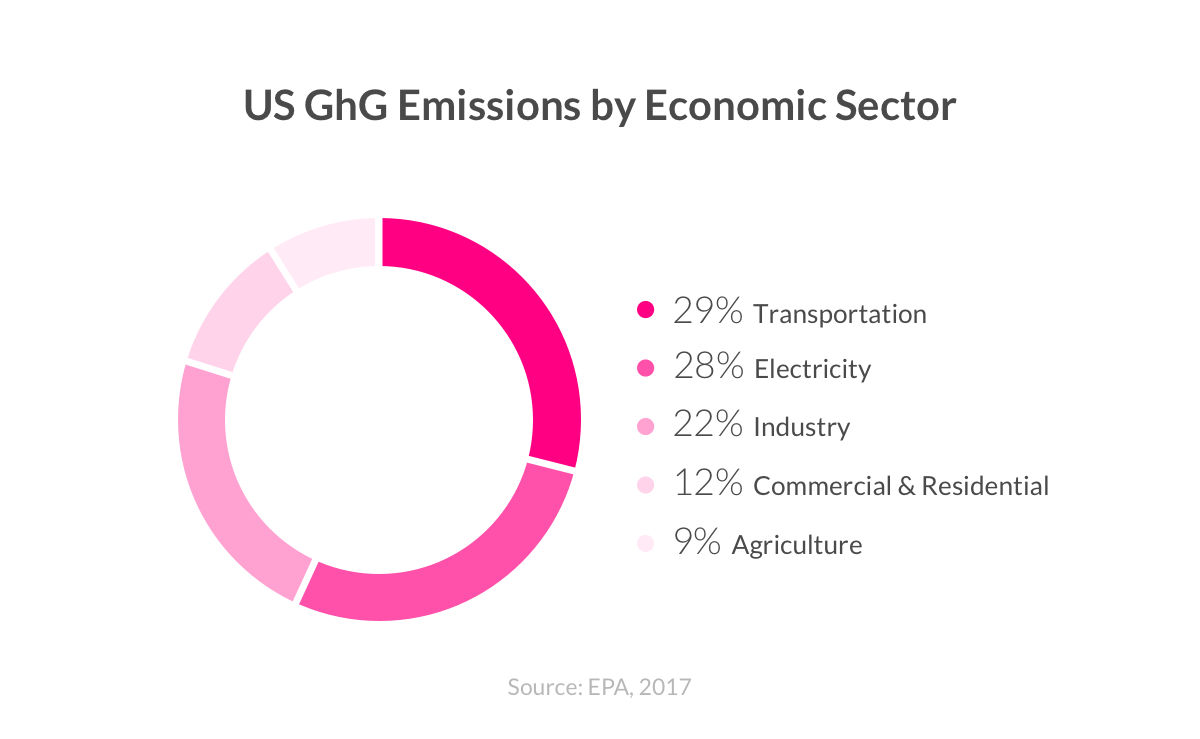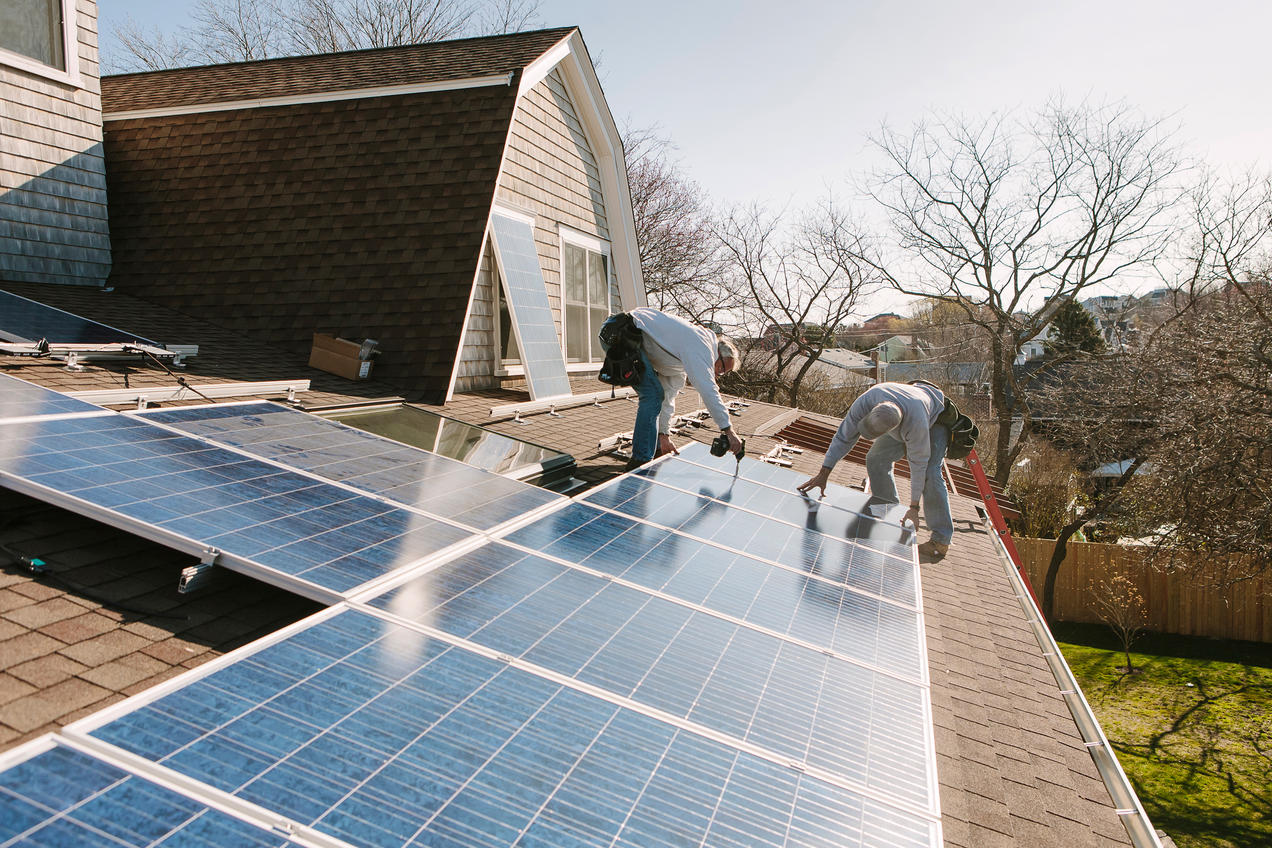How to Solve Global Warming – You’ve probably heard our planet is in trouble: glaciers are melting, sea levels are rising, and wildfires, hurricanes, and heat waves are becoming more severe. And you’ve probably had friends, influencers, and media outlets tell you how to help: “Don’t use plastic straws” “Go vegan” “Only use reusable bags.”
But while these tips may be helpful, are they actually impactful?
As it turns out, a lot of the trendy global warming solutions do not make the biggest impact. While it’s beneficial to cut your plastic straw usage, they only account for .0025% of the plastic in our oceans, according to The Atlantic. Not to mention, our plastic problem barely makes a dent in rising temperatures.
So what does?
Table of Contents
Global warming, explained
Let’s start from the beginning. Global warming is caused by too many ‘greenhouse gases’ in our atmosphere – aka, gases that trap heat and warm our planet.
The #1 sector responsible for greenhouse gas emissions in the US is transportation, and cars account for 82% of this, according to the United States Environmental Protection Agency (EPA). Electricity production comes at a close second.

Why do transportation and electricity harm our planet so much? To generate power for these sectors, you need to burn fossil fuels like oil, gas, or coal. Burning fossil fuels releases carbon dioxide, which makes up 82% of the gases in our atmosphere that trap heat, according to the EPA.
In other words, too much transportation and electricity means too many gases in our atmosphere that warm our planet.
But there are other causes of global warming, too. While carbon dioxide takes up most of the headlines, there’s another greenhouse gas that’s seriously warming our planet: methane. It’s responsible for about 20% of global warming, according to National Geographic, and a big portion of methane comes from cows (more on that later).
So who is emitting the most greenhouse gasses? Consider this:
- The US is responsible for the highest number of emissions, and Americans have the highest carbon footprint per capita
- 100 companies (most of them oil and coal producers) are responsible for 71% of the world’s greenhouse gas emissions.
Nations around the world are upping their game in the fight against climate change, even as President Trump recently announced the U.S.’s withdrawal from the Paris Agreement. And despite this reckless move, American mayors, state leaders, county officials, governors, major companies, and millions of citizens across our country have pledged that they’re “still in” when it comes to the agreement, and supporting the goal of limiting future warming to well below 2 degrees Celsius.
Even better, a new initiative by former New York City mayor Michael Bloomberg gives the urban layer of this movement a boost. He’s asked mayors from the 100 most populous cities in the country to share their plans for making their buildings and transportation systems run cleaner and more efficiently. The 20 that show the greatest potential for cutting the dangerous carbon pollution that’s driving climate change will share a total of $70 million in technical assistance funding provided by Bloomberg Philanthropies and partners.
It’s important to remember the equally vital contributions that can be made by private citizens—which is to say, by you. “Change only happens when individuals take action,” Aliya Haq, deputy director of NRDC’s Clean Power Plan initiative, says. “There’s no other way, if it doesn’t start with people.”
The goal is simple. Carbon dioxide is the climate’s worst enemy. It’s released when oil, coal, and other fossil fuels are burned for energy—the energy we use to power our homes, cars, and smartphones. By using less of it, we can curb our own contribution to climate change while also saving money. Here are a dozen easy, effective ways each one of us can make a difference:
How to Solve Global Warming
1. Speak up!
What’s the single biggest way you can make an impact on global climate change? “Talk to your friends and family, and make sure your representatives are making good decisions,” Haq says. By voicing your concerns—via social media or, better yet, directly to your elected officials—you send a message that you care about the warming world. Encourage Congress to enact new laws that limit carbon emissions and require polluters to pay for the emissions they produce. “The main reason elected officials do anything difficult is because their constituents make them,” Haq says. You can help protect public lands, stop offshore drilling, and more here.
2. Power your home with renewable energy.
Choose a utility company that generates at least half its power from wind or solar and has been certified by Green-e Energy, an organization that vets renewable energy options. If that isn’t possible for you, take a look at your electric bill; many utilities now list other ways to support renewable sources on their monthly statements and websites.
3. Weatherize, weatherize, weatherize.
“Building heating and cooling are among the biggest uses of energy,” Haq says. Indeed, heating and air-conditioning account for almost half of home energy use. You can make your space more energy efficient by sealing drafts and ensuring it’s adequately insulated. You can also claim federal tax credits for many energy-efficiency home improvements.
4. Invest in energy-efficient appliances.
Since they were first implemented nationally in 1987, efficiency standards for dozens of appliances and products have kept 2.3 billion tons of carbon dioxide out of the air. That’s about the same amount as the annual carbon pollution coughed up by nearly 440 million cars. “Energy efficiency is the lowest-cost way to reduce emissions,” Haq says. When shopping for refrigerators, washing machines, and other appliances, look for the Energy Star label. It will tell you which are the most efficient.
5. Reduce water waste.
Saving water reduces carbon pollution, too. That’s because it takes a lot of energy to pump, heat, and treat your water. So take shorter showers, turn off the tap while brushing your teeth, and switch to WaterSense-labeled fixtures and appliances. The EPA estimates that if just one out of every 100 American homes were retrofitted with water-efficient fixtures, about 100 million kilowatt-hours of electricity per year would be saved—avoiding 80,000 tons of global warming pollution.
6. Actually eat the food you buy—and make less of it meat.
Approximately 10 percent of U.S. energy use goes into growing, processing, packaging, and shipping food—about 40 percent of which just winds up in the landfill. “If you’re wasting less food, you’re likely cutting down on energy consumption,” Haq says. And since livestock products are among the most resource-intensive to produce, eating meat-free meals can make a big difference, too.Subscribe to Top of MindWe deliver stories that help break down climate topics and bring you inspiration to keep up your activism.
Get the latest fresh in your inbox each Tuesday.SUBSCRIBEWe are committed to protecting your privacy and will never sell, exchange or rent your email address.
7. Buy better bulbs.
LED lightbulbs use up to 80 percent less energy than conventional incandescents. They’re also cheaper in the long run: A 10-watt LED that replaces your traditional 60-watt bulb will save you $125 over the lightbulb’s life.
8. Pull the plug(s).
Taken together, the outlets in your home are likely powering about 65 different devices—an average load for a home in the U.S. Audio and video devices, cordless vacuums and power tools, and other electronics use energy even when they’re not charging. This “idle load” across all U.S. households adds up to the output of 50 large power plants in the U.S. So don’t leave fully charged devices plugged into your home’s outlets, unplug rarely used devices or plug them into power strips and timers, and adjust your computers and monitors to automatically power down to the lowest power mode when not in use.
9. Drive a fuel-efficient vehicle.
Gas-smart cars, such as hybrids and fully electric vehicles, save fuel and money. And once all cars and light trucks meet 2025’s clean car standards, which means averaging 54.5 miles per gallon, they’ll be a mainstay. For good reason: Relative to a national fleet of vehicles that averaged only 28.3 miles per gallon in 2011, Americans will spend $80 billion less at the pump each year and cut their automotive emissions by half. Before you buy a new set of wheels, compare fuel-economy performance here.
10. Maintain your ride.
If all Americans kept their tires properly inflated, we could save 1.2 billion gallons of gas each year. A simple tune-up can boost miles per gallon anywhere from 4 percent to 40 percent, and a new air filter can get you a 10 percent boost.
11. Rethink planes, trains, and automobiles.
Choosing to live in walkable smart-growth cities and towns with quality public transportation leads to less driving, less money spent on fuel, and less pollution in the air. Less frequent flying can make a big difference, too. “Air transport is a major source of climate pollution,” Haq says. “If you can take a train instead, do that.”
12. Shrink your carbon profile.
You can offset the carbon you produce by purchasing carbon offsets, which represent clean power that you can add to the nation’s energy grid in place of power from fossil fuels. But not all carbon offset companies are alike. Do your homework to find the best supplier.
Conclusion
Adopting responsible consumption habits is crucial, be it regarding food (particularly meat), clothing, cosmetics or cleaning products. Last but not least, recycling is an absolute necessity for dealing with waste.
